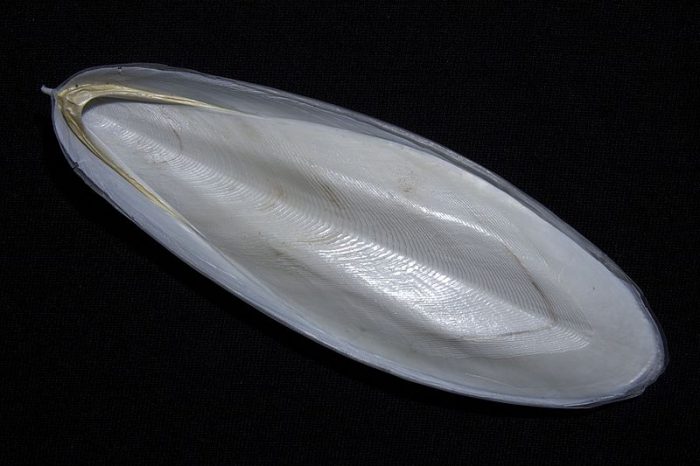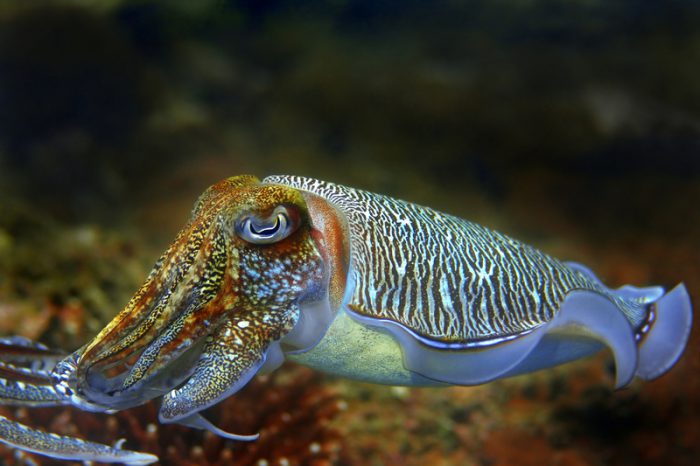Cephalopods, a class of animals that includes octopus and squid, are well known for a few things.
Many are famous escape artists, thanks to their flexible bodies and ability to squirt clouds of ink. Others have remarkable camouflage abilities. And their anatomy—featuring a bulbous, billowy head, and a multitude of muscular tentacles—makes them unlike any other creature on Earth. You don't get the name 'head-foot' (the meaning of 'cephalopod') without being a little out of the ordinary!
They're also wicked smart.
Scientists have proven over and over that octopus are not only the world's smartest invertebrates, they're one of the most intelligent animals, period. And now, a new study has proven that cuttlefish are not far behind their brainy cousins—they just passed 'the marshmallow test'!
What's a marshmallow test?
What is a cuttlefish?

A cuttlebone, the internal shell of the cuttlefish. (Wikimedia Commons)
Cuttlefish are lesser known relatives of octopus and squid. On the outside, they look similar to squid. They have missile-shaped heads; eight arms and two tentacles; feed on mollusks, fish, and shrimp; and many species also use ink to evade prey.
But look closer, and these animals stand out.
One of their main features is the cuttlebone, a long shell inside their head that is unique among cephalopods. They also have really distinct W-shaped pupils on their eyes, something that makes them unique among, well, all other animals!
What is the marshmallow test?
NOT the marshmallow test. But pretty fun nonetheless. (Getty Embed)
Cuttlefish intelligence is very developed. And that brings us to the marshmallow test.
Originally called the Stanford Marshmallow Experiment, this was a test first done in 1972 with young humans. It is a cognitive test—that tests the ability to understand concepts, such as planning for the future and knowing consequences of actions.
In the test, a child is offered a marshmallow. The child is told that they can either eat the marshmallow now, or they can wait 15 minutes when they will get two marshmallows to eat. The purpose of this is to test delayed gratification, a sign that the brain is developed enough to know the advantage of waiting.
A very young child will just eat the marshmallow right away—it is delicious and it's there and they want it! But as humans grow, cognitive abilities grow, too. So older children will tend to wait. It's worth the 15 minutes to double your marshmallows!
The question is, can an animal like a cuttlefish—which is hard-wired to eat as much food as possible to survive the wild—understand delayed gratification, too?
The shrimp-mallow test
Much better for a cuttlefish than a marshmallow. (Getty Embed)
To adapt the test for cuttlefish, scientists used shrimp instead of marshmallows (much more their taste!). And because you can't speak to a cuttlefish, they used symbols to communicate—many cephalopods have shown that they're very good at understanding both shapes and even colours. Here's how it worked.
The researchers tested six cuttlefish in special tanks with two see-through doors.
- One door marked with a circle, would always open immediately.
- The second door, marked with a triangle, would open, but very slowly, after up to two minutes.
- In some cases (called a control group), the second door was marked with a square, meaning it would never open at all.
Behind the circle door, they placed a piece of raw prawn—a tasty morsel for a cuttlefish. But behind the second door, was a whole, live shrimp—a much better catch. If the cuttlefish went for the raw prawn, the live shrimp was immediately removed.
The message was clear. You can have this little snack right away, but that's all you'll get. OR you can wait a bit for the live shrimp door to open and you can have both!
The results? Smart cuttlefish!
You passed, cuttlefish! (Getty Embed)
In every case where the live shrimp was an option (behind the triangle door), the cuttlefish all waited so they could get the better meal. And in the control group (with the closed square door), they understood that the live shrimp was only a temptation they couldn't have, so they went straight for the circle door and the prawn.
They were smart enough to figure out the test and demonstrated exceptional cognitive ability. That puts them in the same intelligence category as primates, dogs, and young humans!
In the end, it's just another example of the potential of cephalopod intelligence. As well as proof of why many biologists think that on alien worlds, a planet's dominant species could look a lot more like them than us.
 Bright in both senses of the word, cuttlefish are remarkable creatures. (Photo
Bright in both senses of the word, cuttlefish are remarkable creatures. (Photo 









lol